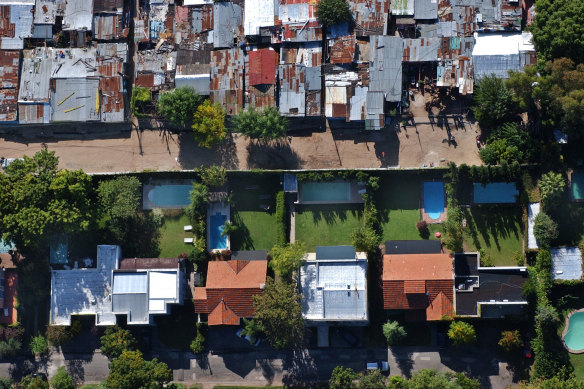Opinion
How can Australians be so wealthy yet still be poor?
Elizabeth Knight
Business columnistHere is a real riddle. How do we reconcile the just-released figures that Australian adults enjoy a median wealth that is the second highest in the world (after Luxembourg) while so many are seemingly struggling to make ends meet?
How can we be so rich yet so poor? Could it be that we rank No.2 for wealth but No.1 for complaining about being poor? Because it is difficult to marry up our statistical financial good fortune with this week’s report from the charity Good360 Australia that one in seven Australians is finding it hard to afford soap or washing powder.
According to the latest UBS Global Wealth Report, the average Australian’s wealth grew by about 10 per cent last year, something any government would normally crow about, but for the fact that both sides of politics have focused their rhetoric on addressing the cost-of-living crisis.

The disparity between the “haves” and the “have-nots” continues to expand.Credit: AP
Before we go any further, it’s important to note that the UBS wealth rankings that put Australia in second spot cite median wealth, not average wealth, so it cuts out the statistical noise created by the fortunes of billionaires such as Andrew Forrest and Gina Rinehart.
So as a nation, Australians are growing their wealth at a real clip – statistically at least. Our median wealth in 2023 grew at 5 per cent but, drilling down further, the average wealth grew at twice that rate – which suggests that wealthier Australians are growing their assets at a faster rate than those who are poor.
The wealth pyramid, as it stands, showcases the growing disparity between the “haves” and the “have-nots.”
There are almost 2 million Australians with more than $1.5 million sitting at the pointy end of the pyramid and roughly the same number at the bottom who have $15,000 or less. In the bulging middle, there are 11.7 million people with between $150,000 and $1.5 million and about 4 million people whose wealth lies between $15,000 and $150,000.
The two lowest wealth bands are exposed to cost-of-living pressure, having been hit the hardest by ongoing inflation pressures.
The media and politicians have focused on the travails of these households – the renters who live in substandard housing, those on social security, and the dumpster divers Greens senator Nick McKim referred to during the inquiry he chaired into supermarket power.
It is hard to believe that the households doing it tough occupy the same economy as Australians booking airline tickets at increasing rates to holiday locally and overseas or those responsible for booming profits of luxury retailers.
Then there are the figures from the big banks, which demonstrate the overall number of borrowers running late on their mortgage repayments (while ticking up a touch) remains quite low by historical standards.
The dissonance around our country’s rich but often struggling citizens can be explained in part by our booming property market.
Those who own a home grow their wealth each year as house values rise, and most of these people will be captured in the top two levels of wealth. That also helps explain why Australia’s median level of wealth has grown by more than 111 per cent since 2008.
The number of US dollar millionaires in Australia is set to keep rising for the remainder of the decade. According to UBS, there should be 2.3 million of them by 2028.
This forecast pattern of the growing number of wealthy people is consistent among many, particularly emerging, countries. But for now, the wealthiest countries per adult are dominated by advanced Western economies.
Luxembourg sits well above the pack, with the median wealth per adult coming in at more than half a million Australian dollars, followed by us at around $388,000. Meanwhile, the average wealth per adult in Australia clocks in at just over $800,000, putting us in fifth position globally.
While these statistics paint a picture of prosperity – and Australia is undoubtedly prosperous – many Australians are slipping into the bottom end of the wealth ladder. Addressing this decline will need more than just election-focused rhetoric from the political parties.
The Market Recap newsletter is a wrap of the day’s trading. Get it each weekday afternoon.